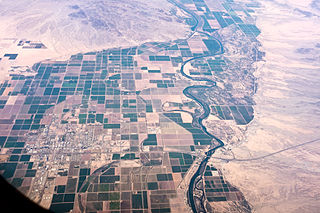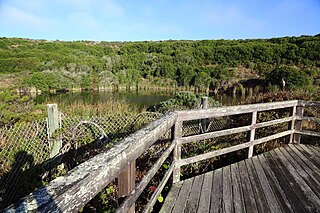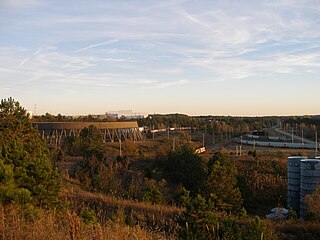Stanislaus Nuclear Power Plant was proposed by Pacific Gas & Electric in 1971 as two GE 1,200 MW units, but the project was canceled in 1979. [1]
A total of 63 nuclear units were canceled in the USA between 1975 and 1980. [2]

The Kintigh Generating Station, also known as Somerset Operating Co. LLC of the Upstate New York Power Producers was a 675-megawatt coal-fired power plant located in Somerset, New York, United States. The plant was owned by AES Corporation until bankruptcy. Its unit was launched into service in 1984. Coal is provided to the plant via the Somerset Railroad. The waste heat is dumped into Lake Ontario, resulting in a warm-water plume visible on satellite images. The plant's 625-foot smoke stack can be seen across Lake Ontario from the shores of Toronto, Pickering, Oshawa, and Ajax, Ontario. It can also be seen from points along the Niagara Escarpment, including Lockport, NY, approximately 20 miles south. Power from the plant is transferred by dual 345kV power lines on wood pylons, which run south from the plant through rural agricultural land. In Royalton, NY they split at their physical junction with the dual circuit 345-kV Niagara-to-Edic transmission line, owned by the New York Power Authority, one circuit heads west to a substation at Niagara Falls, the other heads east to Station 80 south of Rochester. This bulk electric transmission constraint, created by the Somerset plant tie-in and forcing wheeling through 230kV and 345kV transmission lines to the Homer City Coal Plant east of Pittsburgh, PA, and returning to NY at the Watercurry substation outside Elmira, will be resolved through the Empire State Line proposal approved by NY Independent System Operator (NYISO).

The Palo Verde Generating Station is a nuclear power plant located near Tonopah, Arizona, in western Arizona. It is located about 45 miles (72 km) west of downtown Phoenix. Palo Verde generates the largest amount of electricity in the United States per year, and has the second largest rated capacity. It is a critical asset to the Southwest, generating approximately 32 million megawatt-hours annually.

The South Texas Project Electric Generating Station, is a nuclear power station southwest of Bay City, Texas, United States. STP occupies a 12,200-acre (4,900 ha) site west of the Colorado River about 90 miles (140 km) southwest of Houston. It consists of two Westinghouse Pressurized Water Reactors and is cooled by a 7,000-acre (2,800 ha) reservoir, which eliminates the need for cooling towers.
The Black Fox Nuclear Power Plant was a nuclear power plant proposed by the Public Service Company of Oklahoma (PSO) in May 1973. It was cancelled in 1982.

The Susquehanna Steam Electric Station, a nuclear power station, is on the Susquehanna River in Salem Township, Luzerne County, Pennsylvania.
The Alan R. Barton Nuclear Plant was a proposed commercial nuclear power plant in central Alabama, United States.

Between 2007 and 2009, 13 companies applied to the Nuclear Regulatory Commission (NRC) for construction and operating licenses to build 31 new nuclear power reactors in the United States. However, the case for widespread nuclear plant construction has been hampered due to inexpensive natural gas, slow electricity demand growth in a weak US economy, lack of financing, and safety concerns following the Fukushima nuclear disaster at a plant built in the early 1970s which occurred in 2011.

The Sundesert Nuclear Power Plant was a proposed California nuclear power station, formally submitted in 1976. Facing firm opposition from the state's Governor Jerry Brown and denied a permit by a state agency, plans for the construction of the power facility were rejected in 1978 after 100 million dollars had been spent towards its construction. The Sundesert proposal was the last major attempt to build a nuclear plant in California.

The Bodega Bay Nuclear Power Plant was a proposed Northern California nuclear power facility that was stopped by local activism in the 1960s and never built. The foundations, located 2 miles (3.2 km) west of the active San Andreas Fault, were being dug at the time the plant was cancelled. The action has been termed "the birth of the anti-nuclear movement."

The Yellow Creek Nuclear Plant is a canceled nuclear power plant project near Iuka, Mississippi. It was originally planned to have two 1,350-MW (output) reactors operated by the Tennessee Valley Authority (TVA). The steam turbine-generator sets were provided by General Electric.
The Montague Nuclear Power Plant was a proposed nuclear power plant to be located in Montague, Massachusetts. The plant was to consist of two 1150 MWe General Electric boiling water reactors. The project was proposed in 1973 and canceled in 1980, after $29 million was spent on the project.
Sears Island Nuclear Power Plant was a nuclear power plant proposed by Central Maine Power in 1974 as a single 1,150 MW nuclear reactor built by Westinghouse. It was to be built on Sears Island in Maine, but the project was canceled in 1977.
South River Nuclear Power Plant was proposed by Carolina Power & Light in 1973 as three Babcock & Wilcox 1,150 MW units, but the project was canceled in 1978.
The Allens Creek Nuclear Power Plant was a proposed nuclear power plant to be located at Wallis, Texas, less than 50 miles from the western edge of Houston. The plant, consisting of two 1,150 MWe General Electric boiling water reactors, was ordered by Houston Lighting and Power Company (HL&P) in 1973, but public opposition, fueled in part by press coverage of problems at other nuclear plants around the country, led to lengthy public hearings and court action. In the meantime, construction costs escalated and the plant was officially canceled in 1982.
The Atlantic Nuclear Power Plant was a proposed floating nuclear power plant located off the coast of New Jersey. It was proposed in the 1970s by the Public Service Electric and Gas Company. Two Westinghouse 1,150 MWe (net) pressurized water reactors were ordered in 1972, and another two Westinghouse 1,150 MWe (net) reactors were ordered in 1973. The four unit power plant proposal was canceled in 1978.
The Blue Hills Nuclear Power Plant was a proposed commercial nuclear power plant 20 miles northeast of Jasper, Texas. It was proposed in the 1970s by the Gulf States Utilities Company. One 918 MWe pressurized water reactor was ordered in 1973, and an additional 918 MWe reactor was ordered in 1974 from Combustion Engineering. The two unit power plant proposal was canceled in 1978.
The Erie Nuclear Power Plant was a proposed nuclear power plant to be located 9 miles (14 km) southeast of Sandusky, Ohio. It was proposed in 1976 by Ohio Edison for the Central Area Power Coordination (CAPCO). The plant was to consist of two Babcock & Wilcox 1,267 megawatt reactors. Unit 1 was scheduled to be complete in 1986, Unit 2 in 1988. Preliminary work was canceled in 1980 due to new federal requirements placed on nuclear plants that make their construction more expensive and by a drop in anticipated customer energy demand.
The Forked River Nuclear Power Plant was a proposed nuclear power plant in Lacey Township in Ocean County, New Jersey. It was proposed as a single 1,070 MW reactor in 1969 to be built by Combustion Engineering and operated by Jersey Central Power and Light. The facility would have been located on a site between JCP&L's existing Oyster Creek Nuclear Generating Station and the Garden State Parkway. Unlike the Oyster Creek Plant, the Forked River Plant would have a cooling tower to prevent the release of hot water into Oyster Creek and Barnegat Bay.
The Greene County Nuclear Power Plant was proposed in 1974 by the Power Authority of the State of New York. A single 1,212 MWe Babcock & Wilcox pressurized water reactor was to be built approximately 5 miles south of Catskill, New York on the western shore of the Hudson River, but the plant proposal was canceled in 1979, largely due to concerns over social and economic disruptions to the local communities.

The Haven Nuclear Power Plant was a proposed nuclear power plant in Haven, Wisconsin north of Sheboygan at the site of closed military camp called Camp Haven. The power plant was proposed in the 1970s by Wisconsin Electric, but was never built. Two 900 MWe Westinghouse pressurized water reactor were proposed in 1973. Reactor one was canceled in 1978 and reactor two was canceled in 1980. After plans never materialized, the Kohler Company purchased the site. Construction of the Whistling Straits golf course began in 1995.